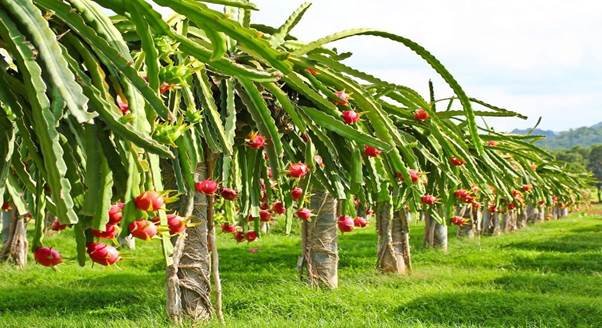Dragon Fruit cultivation area expected to expand to 50,000 hectares in five years
Centre of Excellence (CoE) for Kamalam Fruit to be set up at IIHR, Bengaluru
In India, the cultivation of Kamalam or Dragon Fruit is fast picking up and farmers of Karnataka, Kerala, Tamil Nadu, Maharashtra, Gujarat, Chhattisgarh, Odisha, West Bengal, Andhra Pradesh, Andaman & Nicobar Islands, Mizoram and Nagaland have taken up its cultivation. Presently, the total area under cultivation of Dragon Fruit in India is more than 3,000 ha. which is not able to meet the domestic demand, hence the majority of the dragon fruits available in the Indian market are imported from Thailand, Malaysia, Vietnam and Sri Lanka.
Under the Mission for Integrated Development of Horticulture (MIDH), a roadmap is being prepared for the cultivation of this crop in the identified potential area to increase the production of exotic and niche area fruits including Kamalam. The target for area expansion under MIDH for Kamalam is 50,000 ha. in 5 years. The cultivation of this fruit has started recently and a plantation of this healthy fruit is established at ICAR-Central Island Agricultural Research Institute, Port-Blair, Andaman and Nicobar Islands and IIHR, Bengaluru, Karnataka.
Under MIDH, the Ministry of Agriculture & Farmers Welfare has approved a Centre of Excellence (CoE) for Kamalam Fruit to be established by the Indian Institute of Horticultural Research (IIHR), Bengaluru, Karnataka at Hirehalli, Bengaluru, Karnataka to focus on production, post-harvest and value addition of Kamalam.
The Centre will work for the development of the latest production technology as per the international standard & off-season production and demonstration of these technologies for high-yield production. The Centre will aim to achieve self-sustenance in Kamalam fruit production, value addition and enhance the economic development of the farming community.
In India, Kamalam import started in 2017 with a quantity of 327 tonnes, which has increased sharply to 9,162 tonnes in 2019 and the estimated import for 2020 and 2021 is about 11,916 and 15,491 tonnes, respectively. The projected import value was about Rupees 100 crores for 2021. Dragon fruit provides a fast return with economic production in the first year after planting and full production is attained in 3-4 years. The life expectancy of the crop is about 20 years. The average economic yield after 2 years of planting is 10 tonnes per acre. At present, the market rate is Rs 100 per kg of fruit, so the revenue generated by selling fruits per year is Rs 10,00,000. The Benefit Cost Ratio (BCR) is 2.58.
Centre of Excellence (CoE) for Kamalam Fruit


